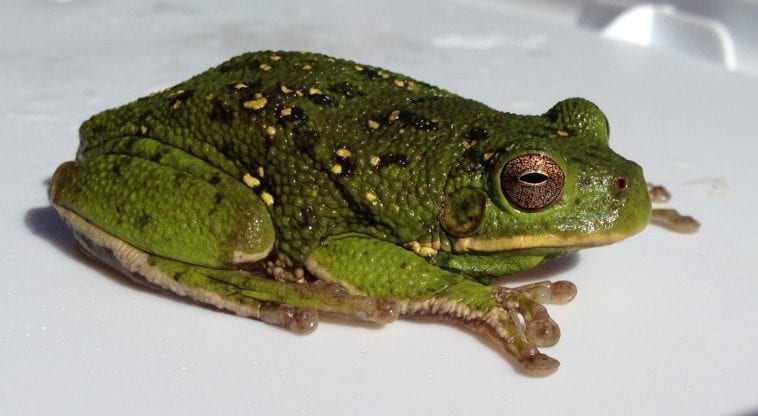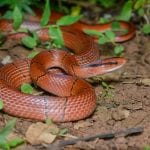Scientific Facts
| Common Name | Barking Tree Frog |
| Scientific Name | Hyla gratiosa |
| Captive Lifespan | 8 to 12 Years |
| Size | 2 – 2.5 inches |
| Mass | No data available |
| Habitat | Terrestrial, temperate, freshwater trees, bushes in forests, and around water bodies |
| Country of Origin | Southeastern United States of America |
Physical Description

The barking tree frog has a plump, chubby, bulky body, colored in dull or bright gray, brown, yellowish or green. The back is marked with round spots. These spots are dark gray in color but tend to fade as the body coloration changes, sometimes turning into greenish-yellowish, small flecks.
Interestingly, the changes in body coloration typical for the Barking Tree Frog tend to be rapid, with the round spots seemingly disappearing just to reappear again over time.
The uniformly bumpy skin of Hyla gratiosa is easily distinguishable thanks to the granular, goose bumps-like texture. The skin of this frog species is unlike the skin of any other American frogs. Furthermore, the skin is leathery and fairly thick, capable of changing its coloration depending on a number of factors, namely the surroundings, the time of the day, temperature, and lighting.
In some barking tree frogs, the sides of the body may be further pronounced by light, irregularly bordered stripes.
The toe pads of barking frogs are rather enlarged, rounded, and sticky, with their disc projections-like toes being perfect for the purpose of suiting these creature’s arboreal nature, allowing them to tightly grip a branch or a perch of just about any kind.
The eyes of these frogs are colored in shades of black, brown, or gold.
Types
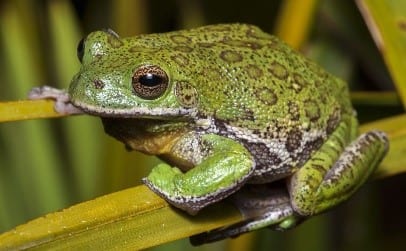
The barking tree frog is part of the Hylidae family, the Hyla genus. Apart from the Hylidae family, the Hylinae sub-family accommodates other tree frogs that do not belong to the Hyla genus of tree frogs, and they also do not belong to any of the other three sub-families of Hylids.
There are no subspecies of Hyla gratiosa.
While the male barking tree frog has a vocal sac, females are easily distinguishable as they lack a vocal sac.
Habitat & Lifespan
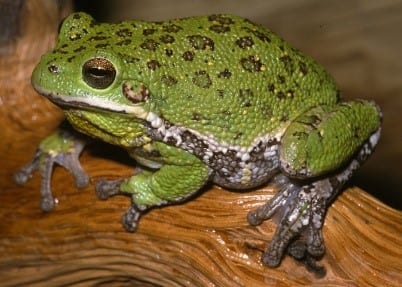
Barking tree frogs are known to occupy a wide variety of habitats throughout most of Florida. Being primarily arboreal, these frogs spend most of their time high in treetops, where these creatures are safe from many of their natural predators. However, they can be also commonly found burrowed deep into the mud.
Barking tree frogs burrow into the mud or sand, typically under logs and/or grass, perfectly camouflaging themselves.
As these frogs reside both in water and on land, they can be commonly spotted digging themselves into the ground during dry weather, where clusters of vegetation and tree roots provide much-needed moisture.
During the breeding season, barking tree frogs are to gather in groups at permanent water bodies.
As of now, too little is known about the lifespan of these frogs in the wild.
When it comes to the lifespan of captive Barking Tree Frogs, these creatures have the reputation of being long-lived, reaching 7 years on average, but fully capable of living for more than 10 years, when provided with proper care. The longest recorded lifespan of a captive Barking Tree Frog is 12.5 years.
Behavior
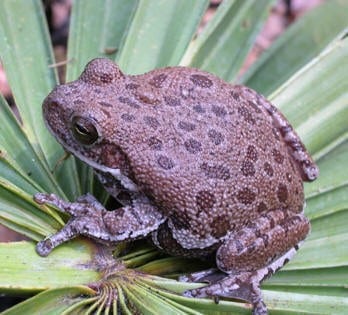
Barking tree frogs are rather solitary creatures, even though they are also known to the chorus with various frogs of the same or similar species in the wild.
Just like the very name suggests, these frogs have earned a solid reputation for their unique, strident, loud, barking-like call. The mating call of Hyta gratiosa may sometimes be made up of a single-syllable, repetitively used to attract females.
Barking tree frogs prefer to spend the day resting high up in the trees. When temperatures become too hot, these creatures are to burrow into the ground.
Housing
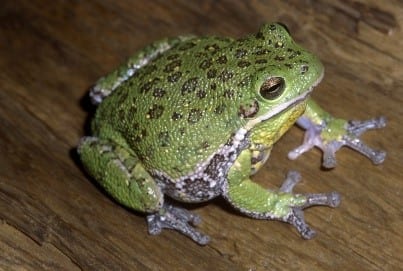
- For housing a single barking tree frog, a 10-gallon tank will do great.
- If housing a few of these amphibians, caregivers need to opt for a 15-gallon tank for cohabitating two adult barking tree frogs, or respectively, for a 20-gallon tank when it comes to cohabitating three mature Hyla gratiosa.
- A pond that is relatively small, yet suitably-sized according to the number of barking tree frogs within the terrarium, must be provided. The pond will allow the frog/frogs to take a refreshing dip whenever needed.
- The size of the frog pond/frog pool should be 2 and up to 3 times the body dimensions of the frog itself (consider both width and length).
- The height of the pond should be similar to the height of the frog itself. The goal is to make sure that your barking tree frog pet will be capable of taking a swim whenever desired. Providing enough room for swimming a few laps will do great.
- Once the caregiver is armed with a suitably-sized tank, climbing options, and a frog pond is created inside, more than half of the job is done, as far as setting up a reliable, comfortable terrarium is concerned. A frog pond will greatly help in maintaining proper humidity levels with barking tree frogs, unlike with other types of frogs known to require far more complex humidity maintenance.
- A barking tree frog’s terrarium should be equipped with a few hiding spots. Hiding spots are crucial for providing these creatures a place to spend some quality alone-time whenever desired (typically only once in a while), as well as for being able to hide if stressed or scared.
- It is a must to ensure that the terrarium will provide suitable climbing options, such as commercially-available perches, driftwood, or other creative pieces that can suit the same purpose.
Substrate
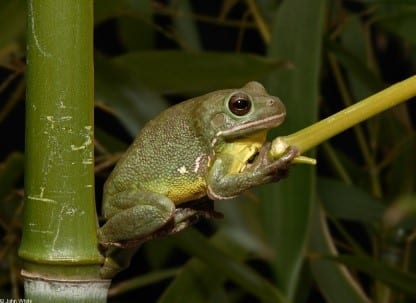
- As a rule of thumb, make sure the substrate you use is soft, as barking tree frogs will sometimes burrow inside the substrate, whether to thermo-regulate themselves properly during hot weather if the frogs are housed outdoors, or whether it comes to taking a rest or hiding every once in a while.
- Captive barking tree frogs will thrive in a wide variety of substrates. Caregivers can utilize something as simple as paper towels to more natural substrate options, such as green or peat moss, orchid bark, and coco coir mixture, or solely coco coir.
- The bottom of the enclosure needs a drainage layer. A drainage layer can be made by using expanded clay pellets or large-grade pea gravel. The pellets or gravel layer should then be covered with a suitable screen, such as a fiberglass window, to prevent fine particles of the substrate from potentially filling some or all of the drainage layer’s gaps.
- Caregivers can alternatively use a 2-3 inch sponge as a suitable substrate base drainage layer. Soak the sponge in water and then carefully squeeze it to prevent any unwanted dripping.
- Once the damp sponge is placed at the bottom of the enclosure, sphagnum moss, crushed bark, coconut fiber (pulverized), or cork can be added to form the upper layer of the substrate.
- Climbing-friendly plants (or other similar structures), as well as hiding places, are of paramount importance for taking care of a healthy, happy Barking tree frog. Apart from a suitable substrate, keepers want to use leafy foliage, wood logs, and/or coconut shells turned upside down to re-create the natural habitat of these amazing creatures.
- Both live and artificial plants can do just fine. However, if feasible, caregivers are strongly encouraged to opt for using natural plants within the terrarium and picking the substrate accordingly. Suitable barking tree frog-friendly live plants encompass large-leaved, sturdy varieties, including but not limited to dieffenbachia, pothos, philodendron, and Aglaonema.
Important Note
Water bodies are not as significant for captive barking tree frogs as climbing, and hiding spots are due to these amphibians’ arboreal and somewhat fossorial (burrowing) nature. However, having a water body (apart from the crucial water bowl) intact within the terrarium is highly recommended, as these frogs are known to call for their mates while floating in the water. Also, if the caregiver intends to breed his/her barking tree frogs, a suitable water body is a must.
Temperature, Lighting & Humidity
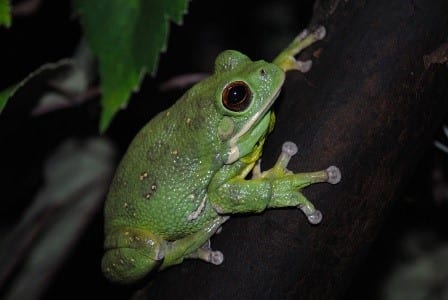
1. In their natural environment in the wild, Barking tree frogs are known to thrive at temperatures within the 70 – 80 degrees Fahrenheit range. This is the exact temperature range that caregivers need to simulate within these beautiful amphibians’ enclosures.
2. As Hyla gratiosa species is also known to enjoy a bit of a winter snooze during the colder months in the wild, it is perfectly fine for caregivers to allow the temperatures to reach a drop of 10 – 15 degrees from the lower end.
3. In the warmer end of the enclosure, keepers can take advantage of a low wattage heating lamp, equipped with a reliable timer for perfect control. Alternatively, an under-tank heating pad controlled by a thermostat can be utilized.
Important Note
Timers and thermostats can grant keepers the much-needed control over the temperatures within the enclosure without much of a fuss involved. However, it is always best to make use of a temperature strip or a thermometer in the terrarium for precise monitoring of the temperature rates within the captive barking tree frog’s world.
4. For indoor enclosures, a 12 hour light cycle is needed to ensure the health, comfort, and proper development of barking frogs. For this purpose, keepers can utilize a daylight (incandescent) bulb or a fluorescent bulb.
5. Even though barking tree frogs’ light requirements are not as fussy as those of other frogs kept as pets, when setting up an appropriate lighting system, it is best that the light bulbs are to emit both UB-B and UV-A light. The closer the color spectrum to the natural daylight spectrum, the better. For the incandescent light bulb, opt for those in the 3200 Kelvin color temperature, vs. 5600 Kelvin for fluorescent lights.
6. Barking tree frogs require a fairly high degree of humidity in order to thrive, the sweetest spot being anywhere between 50% and up to 75% humidity.
Important Note
Do not merely guess humidity levels within the enclosure. Make sure to use a reliable hygrometer. Mind that humidity is probably the trickiest factor related to taking care of a barking tree frog, since these charming amphibians are generally low maintenance, yet this does not mean that the keeper can afford to neglect their humidity and temperature requirements.
7. At any cost, do NOT try to increase humidity by reducing ventilation. Reducing ventilation will, indeed, prevent moisture from leaking out of the enclosure, however, in the lack of proper ventilation, these creatures will certainly fall sick, and in severe cases, they can die.
8. In order to ensure proper humidity for a captive barking tree frog to live up to its fullest potential, ensure a suitably-sized water dish/frog pond is provided within the enclosure. Also, daily misting of the enclosure remains a must. Apart from hand misters, keepers can also take advantage of automated reptile misters.
9. The barking frog’s terrarium should be misted several times on a daily basis, and not just once a day. For maintaining humidity within the needed rates, misting the enclosure two-three times every day will work perfectly.
Diet
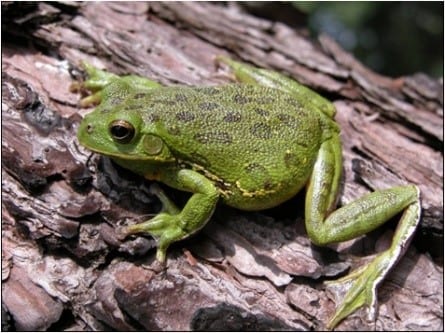
Barking tree frogs are carnivorous, and in particular, insectivorous creatures. In the wild, they feed on a variety of live insects, as well as on some smaller frogs.
Eating Habits
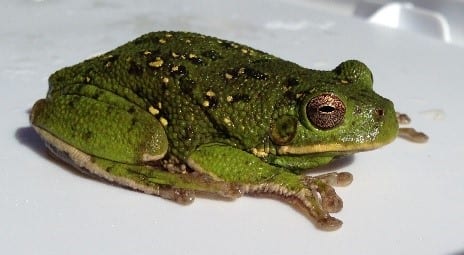
As far as the eating habits of Barking tree frogs are concerned, similarly to any other aspect of these creatures’ care requirements and behavior in captivity, these amphibians are not too pretentious. They will gladly eat just about anything that moves, and that can fit into their mouths, with live food being the most favored festive treat.
Barking tree frogs love snacking on wax worms, fruit flies, insect larvae, and crickets.
The primary diet for captive barking tree frogs is fairly straightforward: crickets! These frogs’ diet only needs to be varied occasionally, with other offerings, such as wax worms or fruit flies, only needed for spicing things up every once in a while.
As a rule of thumb, every alternate feed must be dusted with a calcium and multivitamin supplement.
Keepers only need to feed their barking tree frog pets every alternate day.
A typical feeding routine consists of 4 – 6 crickets. Do keep in mind, though, that this number is only a basic suggestion. The number of crickets a barking tree frog will require may vary from one individual to another. Therefore, caregivers want to feed the frog and observe the results, so that more or fewer crickets can be supplemented accordingly.
Note
At any cost, overfeeding must be avoided. If these arboreal animals are to put on a few excess ounces, this can make their climbing-oriented lifestyle quite difficult. The secret to establishing a well-working feeding routine is just a little bit of patience and a healthy dose of observation.
Sleeping Habits
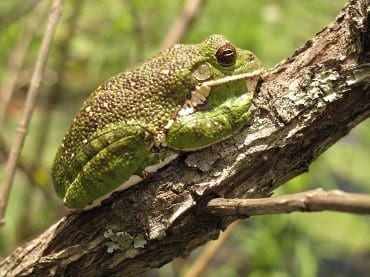
Barking tree frogs are nocturnal. These extraordinary amphibians tend to be less active during the day when they prefer to rest high up in the trees.
These frogs do not necessarily hibernate unless the climate conditions stimulate them to do so. While Hyla gratiosa are known to aestivate during hot and dry weather, and they will hibernate when the weather is cold. Aestivation refers to a process that is similar to hibernation, as aestivation is a period of inactivity that is undergone by some animals for the purpose of protecting them from external elements.
Interestingly, no matter whether it comes to aestivatin in warm, dry weather or hibernation in cold weather, Barking Tree Frogs will burrow into the ground, under cover of roots and other natural vegetation.
It is because of the intriguing behavior characterizing barking tree frogs’ aestivation and hibernation habits why these animals are not considered strictly arboreal but also somewhat fossorial.
Water
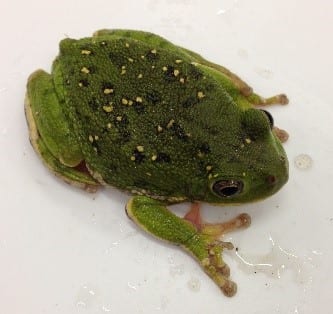
- A large water dish filled with clean, freshwater must be provided at all times so that captive barking tree frogs can soak themselves regularly, whenever needed.
- Mind that all frogs, including barking tree frogs, are extremely sensitive to oils, soaps, and chlorine, so any water that gets within the enclosure must be free of any of these substances.
- For filling the frog pond and the water dish of your captive barking frog, as well as when it comes to keeping the substrate moist and misting the enclosure daily, always use stale, de-chlorinated water. To stale the water, leave it for a few hours prior to using it. Also, it is highly recommendable to take advantage of a de-chlorinator so that you won’t have to constantly purchase readily-available de-chlorinated water.
- Another alternative to using a de-chlorinator is to simply collect fresh rainwater. Rainwater can be used directly after being collected.
- Make sure you only start collecting rainwater for your barking tree frog at least 30 minutes after the rain has started, since the first showers of rain will most probably contain various pollutants, such as Nitrous Oxide and Sulfur Dioxide, and these pollutants can compromise the well-being of your amphibian pet. Also, the first few showers are highly likely to contain suspended particulate matter, which makes the water too acidic.
Development and Reproduction
Once the eggs have been deposited, it takes about 7 days for tadpoles to hatch. Within only a couple of days after hatching, tadpoles will feed on algae, as their gills will start to function at this point.
Tadpoles are fairly large in size, with an average length of 5 cm. Metamorphosis occurs within 1 ½ and up to 2 months.
As to the mating habits of barking tree frogs in the wild, these creatures are known to be polygynous, mating seasonally. Females breed only once during the mating season, while males are known to mate for up to 17 times in one mating season.
When the mating season begins in March, continuing through August, groups of male barking tree frogs are to gather at permanent water bodies, such as ponds, streams, and lakes, among others. Then the males are to call for a female mate, using their distinct, barking-like mating call. Usually, there are no more than 20 – 25 males in the mating group.
Breeding choruses are often formed on highly humid, rainy nights, in breeding areas that are commonly found in various water pools characterized by open canopies, or ponds that are greatly dominated by vegetation.
It is the female barking tree frog to choose a male to mate with, based on the sound of the male’s mating call.
Male and female barking tree frogs alike reach sexual maturity at four years of age.Fertilization occurs externally, with 2000 or more eggs being the result of successful fertilization.
Females are to deposit the eggs on the bottom of a water body one at a time.
The size of barking frogs’ eggs ranges from 1 to 1.8 mm in diameter.
The parental care of barking tree frogs ends with depositing the eggs, as the females provision the eggs with the much-needed nutrients to allow tadpoles to develop properly and hatch successfully. For heightening reproductive success, though, females are to deposit many more eggs to increase chances of survival, instead of applying active parental care for their offspring.
How to Breed

During the mating season, telling apart male barking tree frogs from females is easy, as the males develop a distinct coloration on their throats, in the vocal sacs area.
For breeding these colorful creatures, you need a pair of a healthy, sexually mature male and a female. Both need to be well-fed so that fertilization chances will be much higher.
Add the pair of frogs into a suitably-sized aquarium (15-gallon will work great). On the bottom of the breeding aquarium, add several inches of water, and layer up dead grass. Push the dead grass down into the water until the grass is no longer capable of floating above the surface.
Close the aquarium with a suitable lid, but do make sure there is proper ventilation so that the pair does not end up in suffering. Mating typically occurs late at night, so the morning after adding the pair into the breeding aquarium, breeders should be able to notice many eggs deposited.
The deposited eggs will be attached to the grass you have layered on the bottom of the tank, and the mating pair should be removed from the breeding aquarium at this point.
In less than a week, the tiny tadpoles will emerge. Feed them floating fish food.
Handling
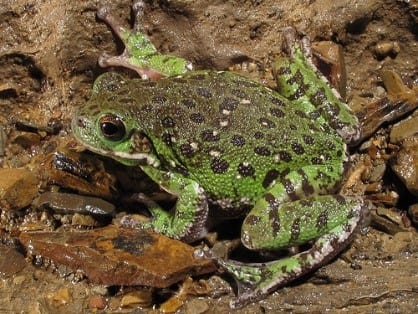
- Before handling your barking tree frog pet, always wash your hands thoroughly with water but without any soaps or oils. Remember, the skin of these amphibians is very sensitive, and you can cause them serious health damage by handling them with hands treated with lotions, soaps, perfumes, etc.
- Do not hurry to handle your newly acquired barking tree frog. The amphibian will require some time to get better used to its new habitat (at least two weeks). Let the creature take its time and do not stress it by excess handling at this point.
- As a rule of thumb, do NOT handle barking tree frogs regularly. Even when raised in captivity, these creatures remain wild at heart, and their natural instincts typically guide them towards easily experiencing stress when handled.
- Remember, a stressed frog will not remain healthy for long, so by avoiding frequent handling, you have higher chances of watching your amphibian friend grow and develop in perfect well-being, all while beautifully keeping you company for many years to come.
- Handling a barking tree frog is best to happen during feeding. This way, the amphibian will be less stressed because of being more interested in food rather than feeling nervous. At feeding time, place food on your hand and allow the frog to come and eat out of your hand.
- Only lift the frog gently, without abrupt moves or loud noises involved. Respect the creature, and let it feel at ease while eating out of your hand. Do not squeeze it.
- Enjoy watching your barking tree frog fondly feeding while sitting on your palm, but then again, do not handle these creatures too often, no matter how pleasurable it feels to spend some quality time together while engaged in handling practices.
- Wash your hands thoroughly with soapy, hot water every time after handling a barking tree frog.
How to Treat and Prevent Possible Health Issues
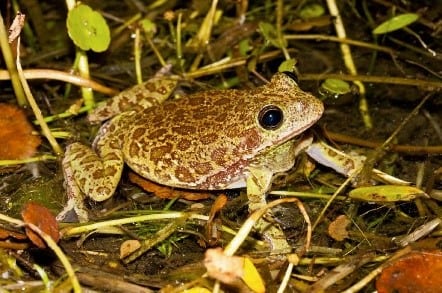
- Do not overfeed your barking tree frog pet. These creatures have a voracious appetite, so keepers must be strict enough as to only provide as much food as needed.
- Only use de-chlorinated water.
- Make sure to utilize a reliable hygrometer and thermometer for monitoring temperature and humidity rates at all times, and make adjustments as quickly as possible if necessary.
Possible Dangers to Humans
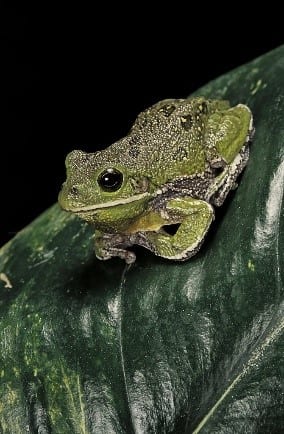
Like snakes, salamanders, turtles, and other frogs, barking tree frogs can carry Salmonella bacteria. Salmonella can cause severe illness in humans, so washing your hands every time after getting in touch with a barking frog and/or any pieces of equipment and decoration within the enclosure is a must. Young children must never be left unattended with a barking tree frog pet.
Availability: How to Get a Barking Tree Frog?
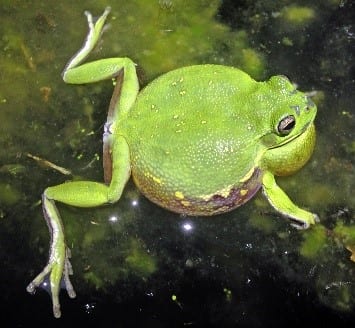
As with all other reptiles and amphibians alike, it is always best to take a barking tree frog from reputable retailers or breeders.
Do not purchase a barking tree frog from breeders or retailers who cannot offer any guarantee of the captive origin and perfect health status of the animal. Wild-caught barking tree frogs stand a higher chance of being infected with Salmonella bacteria that can transfer to humans, and they will almost certainly carry parasites, so captive-bred frogs make the most reliable and sensible choice.
Fun Facts
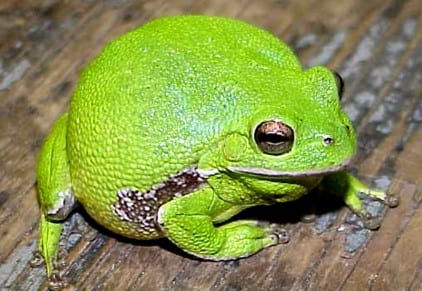
- Barking tree frogs are the largest tree frogs native to the United States.
- Barking tree frogs use predominantly vocal communication. For instance, when the male is to call a female, no other visual clues are used by the mating pair.
- In order to communicate, Hyla gratiosa is known to use two different calls. The first type of call is given when these frogs are around water and are ready to mate. This call is rather loud and reiterated every 1 – 2 seconds. The other type of communication call is made up of 9 – 10 harsh syllables. It resembles a dog barking, and hence the name of these extraordinary tree frogs.
- Apart from vocal communication, experts believe that barking tree frogs use visual clues for the purpose of perceiving the surroundings in their environment. Because of having the large-spanning vision, barking tree frogs can detect any movement in their environment easily and quickly.
- Female barking tree frogs are to pick a male to mate with based on the strength of the mating call, which has much to do with the maturity and proper health status of the male. However, females are also highly more likely to pick a male to mate with provided the attractive call is not located more than five meters away from the female.
- Barking tree frogs play an essential role as part of the ecosystem. Barking frogs’ diet in the wild consists of many arboreal insects. Meanwhile, barking tree frogs themselves are prey to various snakes, raccoons, and birds, thus, making up for a complex food web where barking tree frogs are key players.
- One of the positive impacts that barking tree frogs have on the environment, and in return, to us, humans, is that since these amphibians would often burrow into the ground in the wild, this contributes to soil aeration.
- Thanks to thriving on insects, barking tree frogs can be extremely helpful in pest populations’ regulation.
- In areas where the green tree frogs and the barking tree frogs are to breed in the wild, it is not uncommon for “accidents” to happen when a green tree frog and a barking tree frog get to mate. The result of such intriguing accidents is hybrids. These hybrids have a strong resemblance to both species. In the vast crowd of croaking, hybrids are fairly easy to locate, as their call is significantly (and clearly) distinguishable from the calls of “pure” green and barking tree frogs alike.
How to Take Care of a Barking Tree Frog
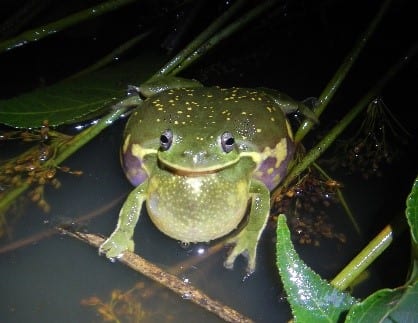
- The easiest way to tell that you are taking good care of your barking tree frog friend is the body coloration. A healthy (and happy) Hyla gratiosa should be brightly colored. Even though these creatures are known as masters of camouflage, changing and managing body coloration swiftly whenever desired or needed, they will generally always return back to their vivid, basic body coloration when feeling good, instead of stressed, threatened, or sick.
- Barking tree frogs, like all tree frogs, adore climbing. As soon as caregivers meet this super basic requirement with this easy-to-take-care-of amphibian, half the battle is already won. The rest sums down to maintaining proper temperature and humidity, always using de-chlorinated water, and avoiding frequent, excess handling.
- Even though barking tree frogs are low maintenance animals, do make sure you spot clean the floor of the habitat at least once every week. Clean the entire terrarium at least every two weeks. Do not use harsh chemicals and remove every trace of possible irritants, such as oils or soaps, before bringing the barking tree frog back into the enclosure after cleaning services.
FAQs
Do Barking Tree Frogs Bark?
No, barking tree frogs do not really bark. Barking tree frogs make a particular low-pitched sound during the rainy season, and this sound highly resembles dog barking to some, and goose honking to others. It is only male barking tree frogs that make this remarkable sound, but then again, it is not accurate to say that these amphibians bark in the same sense as dogs do.
How to Feed Barking Tree Frogs?
Feed barking tree frogs with 4 – 6 appropriately-sized, gut-loaded crickets every other day. Offer additional treats, such as wax worms and earthworms, only once in a while. It is best to feed barking frogs at night, as these amphibians are nocturnal.
Are Barking Tree Frogs Endangered?
Up-to-date, barking tree frogs are listed as least threatened. While the populations of barking tree frogs in the wild are kept steady in number, it is important to respect these creatures and to not take wild barking frogs away from their natural habitat.
Are Barking Tree Frogs Poisonous to Humans?
Unlike poison dart frogs, barking tree frogs are not poisonous to humans. In fact, it is only a handful of frog species are known to pose serious risks related to poisoning in humans.
What Does a Barking Tree Frog Look Like?
The most distinguishable characteristics of barking tree frogs are the goose bumps-like textured skin. Barking tree frogs possess plump bodies, colored in brown, gray, or green, but are fully capable of quickly changing their body coloration to confuse predators, for camouflaging purposes, or whenever stresses or otherwise threatened.
Do Barking Tree Frogs Make a Lot of Noise?
Barking tree frogs do not make a lot of noise, in general. In fact, female barking tree frogs do not make much noise at all, as the remarkable barking-like call is a reserved specialty of male barking tree frogs. Male barking tree frogs sing the loudest during damp weather.
How Do You Take Care of a Barking Tree Frog?
To take care of a barking tree frog, provide a water dish full of fresh, clean, de-chlorinated water. Mist the enclosure with de-chlorinated water daily. Feed the barking tree frog gut-loaded insects, maintain proper temperature and humidity within the enclosure, and clean the enclosure carefully and fully every week.
How Long Do Barking Tree Frogs Live?
Outside of captivity, very little is known about the lifespan of barking tree frogs. However, when it comes to captive barking tree frogs, these amphibians are known to live for about 7.5 years on average. With proper care, though, barking tree frog pets can easily reach 10+ years of age.
Do Barking Tree Frogs Make Good Pets?
For the right keeper, barking tree frogs can make wonderful pets. Barking tree frogs are colorful, amusing, and amazing. These frogs cannot be tamed down, but they will easily take insects from the caregiver’s hands, making up for a unique bond that can last for a lifetime.
Are Barking Tree Frogs Beginner-Friendly Pets?
Yes, barking tree frogs are beginner-friendly pets. As long as their basic care requirements are strictly met, these amphibians are fairly easy to take care of, even by newbies who have no previous experience in the niche.
Can You Cohabitate Multiple Barking Tree Frogs?
Yes, you can cohabitate barking tree frogs. However, your safest bet is that cohabitation is to be avoided, and especially by beginners, since barking tree frogs are known as rather solitary creatures that do best when on their own. If cohabitating barking tree frogs with green tree frogs, this can lead to unequal food competition, due to barking frogs being more slowly than green tree frogs.

